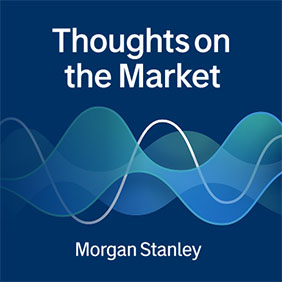Trump‘s AI Action Plan
July 24, 2025
The Trump administration unveiled a 28-page AI Action Plan, outlining more than 90 policy actions, with an ambition for the U.S. to win the AI race. Our Global Head of Fixed Income Research and Public Policy Strategy Michael Zezas, and U.S. Public Policy Strategist Ariana Salvatore, explain why investors need to keep an eye on AI policy.

-
 Michael Zezas
Michael Zezas
Thoughts on the Market
Listen to our financial podcast, featuring perspectives from leaders within Morgan Stanley and their perspectives on the forces shaping markets today.

Up Next
Will the Entertainment Business Stay Human?
Transcript
Welcome to Thoughts on the Market. I’m Ben Swinburne, Morgan Stanley’s U.S. Media and Entertainment Analyst. Today – GenAI is poised to shake up the entertainment business.
It’s Wednesday, July 23, at 10am in New York.
It's never been easier to create art for anyone – with a little help from GenerativeAI. You can transform photos of yourself or loved ones in the style of a popular Japanese movie studio or any era of visual art to your liking. You can create a short movie by simply typing in a few prompts. Even I can speak to you in several different languages. I can ask about the weather:
Hvordan er været i dag?
Wie ist das wetter heute?
आज मौसम कैसा है?
In the media and entertainment industry, GenAI is expected to bring about a seismic shift in how content is made and consumed. A recent production used AI to de-age actors and recreate the likeness of a deceased performer—cutting what used to take hundreds of VFX artists a year to just a few months with a small team. There are many other examples of how GenAI is revolutionizing how stories are told, from scriptwriting and editing to visual effects and dubbing.
In music, GenAI is helping music labels identify emerging talent and generate new compositions. GenAI can even create songs using the voices of long-gone artists – potentially extending revenue far beyond an artist’s lifetime.
GenAI-driven tools have the potential to reduce TV and film production costs by 10–30 percent, with animation and post-production among the biggest savings opportunities. GenAI could also transform how content reaches audiences. Recommendation engines can become even more predictive, using behavioral data to serve up exactly what listeners want—sometimes before we know what we want.
And there’s more studios can achieve in post production. GenAI can already dub content in multiple languages, even syncing mouth movements to match the new dialogue. This makes global distribution faster, cheaper, and more culturally relevant.
With better engagement comes better monetization. Platforms will use GenAI to introduce new pricing tiers, targeted advertising, and personalized superfan content that taps into niche audiences willing to pay more.
But all this innovation brings up profound ethical concerns.
First, there’s the issue of consent and copyright. Can GenAI tools legally use an actor’s name, likeness or voice? Then there’s the question of authorship. If an AI writes a script or composes a song, who owns the rights? The creator or the GenAI model?
Labor unions are understandably worried. In 2023, AI was a major sticking point in negotiations between Hollywood studios and writers’ and actors’ guilds. The fear? That AI could replace human jobs or devalue creative work.
There are also legal battles. Multiple lawsuits are underway over whether AI models trained on copyrighted material without permission violate intellectual property laws. The outcomes of these cases could reshape the entire industry.
But here’s a big question no one can ignore: Will audiences care if content is AI-generated? Some consumers are fascinated by AI-created music or visuals, while others crave the emotional depth and authenticity that comes from human storytelling. Made-by-humans could become a premium label in itself.
Now, despite GenAI’s rapid rise, not every corner of entertainment is vulnerable. Live sports, concerts, and theater remain largely insulated from AI disruption. These experiences thrive on real-time emotion, unpredictability, and human connection—things AI can’t replicate. In an AI-saturated world, the value of live events and sports rights will rise, favoring owners of sports rights and live platforms.
So where do we go from here?
By and large, we’re entering an era where storytelling is no longer limited by budget or geography. GenAI is lowering the barriers to entry, expanding the creative class, and reshaping the economics of media. The winners in this new landscape will likely be companies that can scale—platforms with massive user bases, deep data pools, and the engineering talent to integrate GenAI seamlessly. But there’s also room for agile newcomers who can innovate faster than the incumbents and disrupt the disrupters.
No doubt, as the tools get better, the questions get harder. And that’s where the real story begins.
Thanks for listening. If you enjoy the show, please leave us a review wherever you listen and share Thoughts on the Market with a friend or colleague today.

Asia’s $46 Trillion Question
Transcript
Welcome to Thoughts on the Market. I’m Chetan Ahya, Morgan Stanley’s Chief Asia Economist.
Today – an issue that’s gaining traction in boardrooms and trading floors: the three big decisions Asia investors are facing right now.
It’s Tuesday, July 22nd, at 2 PM in Hong Kong.
So, let’s start with the big picture.
Over the past 13 years, Asia’s international investment position has doubled to a $46 trillion. A sizable proportion of that is invested in U.S. assets.
But the recent weakness in the U.S. dollar gives rise to three important questions for investors across Asia: Should they diversify away from U.S. assets? How much of Asia’s incremental savings should be allocated to the U.S.? Or should they hedge their U.S. exposure more aggressively?
First on the diversification debate. Investors are voicing concern over the U.S. macro outlook, given the twin deficits. At the same time, our U.S. economics team continues to see growth slowing, as better than expected fiscal impulse in the near term will not fully offset the drag from tariffs and tighter immigration policies.
This convergence in U.S. growth and interest rates with global peers—and continued debate about the U.S. dollar’s safe haven status has already led to U.S. dollar depreciation. And our macro strategists expect further depreciation of the U.S.D by another 8-9 percent by [the] second quarter of next year.
So what is the data indicating? Are investors already diversifying?
Let’s look at Asia’s security portfolio as that data is more transparently available. Out of the total international investment of $46 trillion dollars, Asia’s securities portfolio alone is worth $21 trillion. And of that, $8.6 trillion is in U.S. assets as of [the] first quarter of 2025. Now here’s an interesting point: China’s holding had already peaked in 2013, but Asia ex-China’s holdings of U.S. assets has been increasing. Asia ex-China’s U.S. holdings hit a record $7.2 trillion in the first quarter, largely driven by equities.
In other words, in aggregate, Asia investors are not diversifying at the moment. But they are allocating less from their incremental savings. Asia’s current account surplus remains high—at $1.1 trillion in the first quarter. And even if it narrows a bit from here, the structural surplus means Asia’s total international investment position will keep growing.
However, incremental allocations to the U.S. are beginning to decline. The share of U.S. assets in Asia’s securities portfolio peaked at 41.5 percent in the fourth quarter of 2024 and started to dip in the first quarter of this year. In fact, our global cross asset strategist Serena Tang notes that Asian investors have reduced net buying of U.S. equities in the second quarter.
Finally, let’s talk about hedging. Asian investors have started to increase hedging of their U.S. investment position and we see increased hedging demand as one reason why Asian currencies have strengthened recently. Take Taiwan life insurance—often seen as [a] proxy for broader trends. While their hedge ratios were still falling in the first quarter, they started increasing again in the second. That lines up with the sharp appreciation of [the] Taiwanese dollar in the second quarter.
Meanwhile, the currencies of other economies with large U.S. asset holdings have also appreciated since the dollar’s peak. These are clear signals to us that increasing hedging demand is influencing foreign exchange markets.
All in all, Asia’s $46 trillion investment position gives it an enormous influence. Whether investors decide to diversify, allocate less or stay the course, and how much to hedge will affect currency trends going forward.
Thanks for listening. If you enjoy the show, please leave us a review wherever you listen and share Thoughts on the Market with a friend or colleague today.

Sign up to get Morgan Stanley’s Five Ideas newsletter delivered weekly to your inbox.
Subscribed!
Thank you for subscribing to our blog newsletter. Stay tuned to hear about Morgan Stanley ideas!




